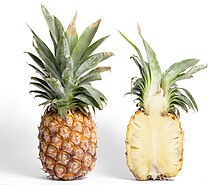Multiple fruit

Multiple fruits, also called collective fruits, are fruiting bodies formed from a cluster of fruiting flowers, the inflorescence. Each flower in the inflorescence produces a fruit, but these mature into a single mass in which each flower has produced a true fruit.[1] After flowering the mass is called an infructescence.[2][3] Examples are the fig, pineapple, mulberry, osage-orange, and breadfruit.
In languages other than English, the meanings of multiple and aggregate fruit are reversed, so that multiple fruits merge several pistils within a single flower.[4]

In the photograph on the left, stages of flowering and fruit development in the noni or Indian mulberry (Morinda citrifolia) can be observed on a single branch. First an inflorescence of white flowers called a head is produced. After fertilization, each flower develops into a drupe, and as the drupes expand, they become connate (merge) into a multiple fleshy fruit called a syncarp. There are also many dry multiple fruits.
Other examples of multiple fruits:
- Plane tree, multiple achenes from multiple flowers, in a single fruit structure
- Mulberry, multiple flowers form one fruit
- Jackfruit, multiple flowers form one fruit
- Fig, multiple flowers similar to mulberry infructescence form a multiple fruit inside the inverted inflorescence. This form is called a Syconium.
See also
References
- ^ Schlegel. Encyclopedic Dictionary of Plant Breeding and Related Subjects. p. 282.
- ^ Hickey, M.; King, C. (2001). The Cambridge Illustrated Glossary of Botanical Terms. Cambridge University Press.
- ^ Beentje, H.; Williamson, J. (2010). The Kew Plant Glossary: an Illustrated Dictionary of Plant Terms. Royal Botanic Gardens, Kew: Kew Publishing.
- ^ Spjut, R.; Thieret, J. (1989). "Confusion between multiple and aggregate fruits". The Botanical Review. 55 (1): 53–72. doi:10.1007/bf02868781.
